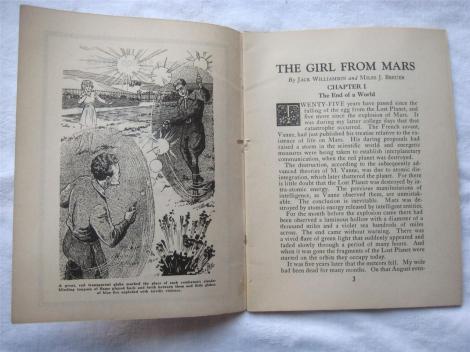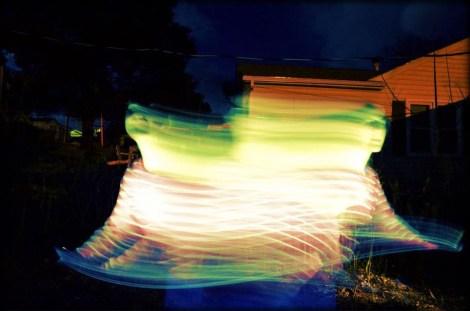I know exactly where my daughter came from. I was cowering, forehead to my wife’s temple, as a doctor lifted Madeleine’s blood- and vernix-dappled body above the surgical drape. I did not peek over while they were sawing a half-foot wound into my wife’s abdomen. I remember the table shaking. I remember the bloody tread marks on the floor afterwards.
These are the kind of details science fiction authors Jack Williamson and Miles J. Breuer avoid. Their literary daughter, Pandorina, emerges from of a metal cylinder. Her adoptive father pulls it from a meteorite’s bloodless crater, not a c-section incision.
“A Girl from Mars” was published in 1929. It was literally the first science fiction story. Pulp publisher Hugo Gernsback, having lost Amazing Stories, launched a new magazine, Science Fiction, with “A Girl from Mars” as its premiere story. It sounds like an obvious name for a magazine, but before Gernsback coined it, the genre was called scientifiction. A term deserving its timely death.
Science Fiction’s readers included high schooler Jerry Siegel, the future co-creator of Superman. A few years later and his own alien child of a destroyed civilization would crash-land on earth to be reared by human foster parents. Miles J. Breuer, a practicing physician when not penning pulp tales, would have been less queasy than his younger writing partner about pregnancy. Though not, apparently, childbirth. Pandorina is a test tube baby, conceived in and hatched from an incubator. Breuer can use the words “ovum,” “sperm,” and “fertilize,” but not “uterus,” “cervix” or “vulva.” Siegel, even less comfortable with the birds and the bees, delivers his sanitized Baby Clark swaddled in a cockpit.
Both birth stories omit female anatomy. Women’s bodies are either missing or sexless. Pandorina is found by a recently widowed husband, Clark by an elderly couple, the wife long past child-bearing years. Instead of vaginas, we get funnel-shaped craters. Instead of intercourse, it’s rocket ships and glass globes shot from interplanetary guns.
But Williamson and Breuer’s narrator seems to love his adopted daughter well enough, rearing her beside his own son. He admires her “rare elflike beauty,” her “soft, red bronze” hair, and her “astonishing aptitude,” all “her inheritance from a higher civilization.” Like Clark, Pandorina passes from infancy to adulthood in less than a page. When I blink at Madeleine—she was just accepted early decision to Wesleyan University this month—I see the same blur of time. Next thing Pandorina’s in love with her adoptive brother, Fred, and glowing in the dark when “excited.” My wife and I haven’t been allowed to check on Madeleine after bed for years and years now, but I suspect she emits a similar “luminosity” behind her closed door.
Perhaps all fathers eventually experience their daughters as alien. After deleting all female genitalia from Pandorina’s birth, Williamson and Breuer’s literary offspring has the audacity to grow her own. My father-tuned ears can hear the unspoken panic stirring under their narrator’s scientifictionally calm prose. Who is this adult woman making herself breakfast in my kitchen before driving herself to school? Where in the universe did she come from?
I’d like to think I’m handling my paternal alienation better than Pandorina’s dad. He sees her entire generation as monsters. Martian men start showing up on the front porch, demanding to wed his virgin daughter. They crash-landed too, one in a farmer’s field in the smallville of Folsom, NJ. The father is horrified as they battle over their would-be bride.
Better they all die, even his own boy Fred, than allow Pandorina to unveil herself on her wedding night. He lures her and the other Martians onto a heavy artillery range where they bloodlessly vanish in the smoke and dirt of an exploding shell. A death as sanitized as their births. I don’t know if Siegel was as terrified by women’s bodies. He avoids opening Pandorina’s box with a sex change operation. Krypton only ejaculates a lone male.
My daughter’s Martian suitors have all been nice boys so far. I try not to embarrass her too much when one steps in from the porch, but it’s hard. Madeleine has ordered us to be “calm” and “not weird,” but my wife and I still gawk. We mumble awkward jokes. Befuddled strangers watching a new civilization take root.
In nine months she flies off to colonize her own planet. God, I’ll miss her.


What a great essay about the father-daughter mystery.
I think children always bring with them a whiff of science fiction, a bit of “how on earth did you get here?” The sci-fi babies from alien planets are partly a good twentieth-century way to ask the questions in Frankenstein. Where did this person get a personality? Opinions? Attitude?
But by the 1930s, Mary Shelley was long gone. Changing medical practices meant few urban Americans had any idea what childbirth looked like, even if they were mothers. For 1930s fathers, babies did arrive neatly scrubbed, wheeled out in metal incubators, like little Clark Kents. No surprise that alien babies arrived the same way!
I wonder what the moral is, if shooting the alien suitors was the “solution”?
Thanks so much, Odessa. Yes, I think turning pregnancy into an “illness” and male doctors pushing out female midwifes turned childbirth into total scifi. For Pandorina, I think her authors killed her and her suitors because culturally the U.S. was shifting away from eguenics and the idea of producing a super race that would replace us. Though I suppose every generation replaces us. I always have that Bowie song in my head: “Oh, you pretty things . . .”